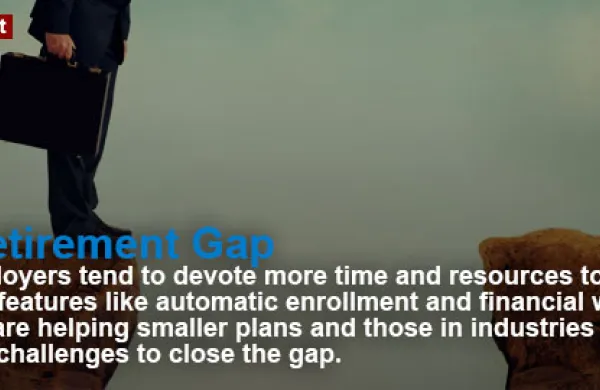When it comes to the quality of today’s employer-sponsored defined contribution plans, excellence is very much in the eye of the beholder. Majorities of plan sponsors believe their DC plan offers high-quality investment options (58 percent), an ample company match (58 percent) and effective financial education (55 percent)—all for reasonable, competitive fees (56 percent) and a competitive expense ratio (54 percent). However, most advisers and consultants say that their plan sponsor clients still frequently encounter problems in each of these areas. The findings come from a recent survey by Institutional Investor, in partnership with Prudential, of more than 500 sponsors of 401(k) plans with assets of $50 million and above and nearly 300 consultants and advisers.
That the glass would look half full to some and half empty to others is understandable. In a few decades, the defined contribution plan has evolved from being just one retirement saving option among many to serving as the central element of most private employers' retirement benefit offerings. “Plans have improved their profile in recent years,” observes Lori Lucas, defined contribution practice leader at Callan Associates, “including streamlining their investment lineups, making greater use of automatic enrollment and reenrollment and keeping fees down.” All too often, though, plan sponsors still are reluctant to add features—for example, auto-enrollment or reenrollment—that might help their participants but that could attract unwanted attention from regulators and litigators. “We see plans' concerns running to minimizing fiduciary risk rather than maximizing outcomes,” Lucas adds.
In reality, however, the two goals do not have to conflict. Consultants describe a road map that can help plan sponsors accomplish both: to minimize fiduciary risk and help guide employees to a successful transition into retirement. “Healthy plans are more institutional in focus,” says Lucas, with a well-defined management structure and processes that include regular review of the plan's features and investment options as well as a budget to support it—not unlike the structure that still underpins defined benefit plans at many large companies. Prudential believes that the regular review of plan wellness should cover three distinct areas:
- Industry trends: Reviewing and adapting the plan to the changing industry landscape to make sure the employer fulfills its fiduciary obligations and serves employees’ best interests;
- Plan design: Optimizing the use of plan features such as automatic enrollment, auto-escalation and company matching to encourage maximum employee participation; and
- Investments: Creating the right menu of investment choices and default options to help direct employees’ investing behavior and enable them to make decisions confidently.
At the outset, employers need to clarify their objectives in offering a DC plan—and show their own commitment by funding it. Plans that feature a sizable match “are much better designed and run in all aspects than those that are not committed to funding,” says Paul Denu, defined contribution practice leader at USI Consulting Group. If the plan includes auto-escalation, for example, the employer should ramp up its match as the employee’s contribution rises. “If it’s going to auto-escalate, the employer should show commitment too,” Denu says.
“At the institutional end, plans are using collective trusts and separate accounts” to keep fees low, says Lucas. Creating diversification in the plan's core investment lineup is critical, says Mark Teborek, senior consulting analyst at Russell Investments, but not easy to achieve: “You can say you cover all the traditional nine style boxes, but you may not be truly diversified.”
Plan sponsors also need to think carefully about their employees' demographic profile and saving habits when designing the plan. Even auto-enrollment can be counterproductive if the initial default rate is set too low, since many participants may assume they do not have to contribute beyond that level, pulling down the average deferred rate, says Ryan Gardner, principal and senior consultant at Fiduciary Investment Advisors.
Employers increasingly are being urged to consider the 401(k) as an element in their total rewards package. At many companies, a manager of total rewards oversees the plan. In addition, a growing number of employers are providing access to education and advice that treat employees’ 401(k) assets as a component of their overall financial picture, including expected Social Security benefits, other assets and household debt. When employees acquire a better grasp of their overall finances, they not only experience less stress, which helps them to be more productive, but are better able to budget larger DC plan contributions. Additionally, both plan sponsors and consultants note that a financial wellness program is becoming a competitive necessity as more companies are offering them.
Taking a holistic view of an employee’s financial health also enables the plan sponsor to better gauge the participant's retirement readiness. This still begins with some fairly simple calculations. At International Paper, which has some $5 billion in 401(k) savings, officials ask three questions: What is the participation rate? What is the average contribution rate? What is the percentage of participants contributing at least enough to claim the full company match? Recordkeepers and third-party vendors have greater data analytic capability today, which allows them to calculate outcomes for employees: say, how long it would take them, and at what saving rate, to achieve an 80 percent income replacement rate in retirement. “Each vendor has their own methodology, but a reasonable replacement target seems to be becoming a standard offering,” says Gardner.
Each company benchmarks itself differently, reflecting its industry and workforce makeup. BMC Software, which has a $700 million 401(k) plan, compares its plan features and performance not only against others in its industry but also against plans at companies of the same size, says Natasha Taylor, director of global benefits.
More sophisticated benchmarking gives plan sponsors a clearer view of how their DC plan stacks up against other companies', providing a better sense of whether their plan really is competitive across a range of features. In the end, however, consultants say, although offering certain features—a diversified core group of investment choices, auto-enrollment, a holistic approach to communication and education—is clearly important, equally significant is the employer's commitment to the plan in the form of resources, attention and ongoing evaluation of each offering.
ABOUT THE SURVEY
This study was developed by Institutional Investor, in partnership with Prudential, to identify the investment risks and behavioral challenges that need to be addressed throughout the retirement planning process and how plan sponsors, advisors and consultants are trying to overcome them.
To support this research, a survey was distributed to Institutional Investor's audience of plan sponsors as well as advisors and consultants between January and February 2016. We received 511 completed survey responses from the plan sponsor audience and 295 completed survey responses from advisors and consultants.
Auto Enrollment: An automatic contribution arrangement that can be used as a feature in a retirement plan to allow employers to enroll employees in the company’s plan automatically upon meeting eligibility requirements.
Auto Escalation: A plan design option that allows a plan sponsor to increase participant deferrals annually by a set increment.
RISKS: Investing involves risk. Some investments are riskier than others. The investment return and principal value will fluctuate, and shares, when sold, may be worth more or less than the original cost, and it is possible to lose money. Past performance does not guarantee future results. Asset allocation and diversification do not assure a profit or protect against loss in declining markets.
The target date is the approximate date when investors plan to retire and may begin withdrawing their money. The asset allocation of the target date funds will become more conservative as the target date approaches by lessening the equity exposure and increasing the exposure in fixed income type investments. The principal value of an investment in a target date fund is not guaranteed at any time, including the target date. There is no guarantee that the fund will provide adequate retirement income. A target date fund should not be selected based solely on age or retirement date. Participants should carefully consider the investment objectives, risks, charges, and expenses of any fund before investing. Funds are not guaranteed investments, and the stated asset allocation may be subject to change. It is possible to lose money by investing in securities, including losses near and following retirement.
© 2016 Prudential Financial, Inc. and its related entities. Prudential, the Prudential logo, the Rock symbol and Bring Your Challenges are service marks of Prudential Financial, Inc., and its related entities, registered in many jurisdictions worldwide.
0294647-00001-00






